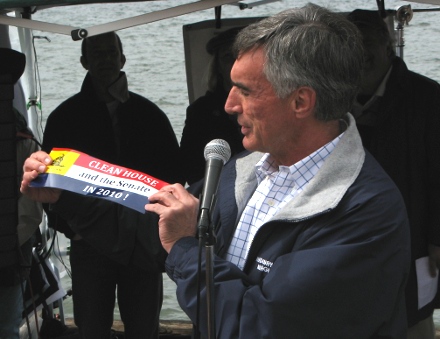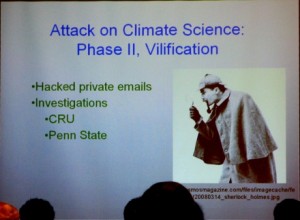Victor Davis Hansen writes excellent essays on many topics but he outdid himself today on the Greek crisis in the EU.
Greece is the canary in the mine of the impending crack-up of the modern welfare state. It is a great gift to us all, this example. A year ago, the socialists, even as they were juggling and falsifying their books, were bragging that the Wall Street meltdown was a referendum — and capitalism was doomed. Now, the entire socialist dream is exposed and even the most ardent statist knows that there is no longer enough “others” to pay the tab.
The poor EU learned that the Greek siesta, the 10PM Athenian dinners, the state power company vans at the beaches in the workday afternoons, the kafenions full of 50-year-old men at 11AM, the angry students perpetually in the streets at each hinted reform, and the moonlighting telephone employees all came at the expense of far harder-working Scandinavian and German socialists, who apparently now realize a nice two weeks each year on Santorini or Crete aren’t worth billions of their own Euros in rescue bailouts.
The Greeks are the most extreme example. I wondered about their society as I watched the unfinished Olympic stadium two months before the Summer Games began in 2004. They scrambled and got it finished but I wondered about the cost at the time. Greece is a lovely theme park for tourists but, as a modern country, it has always been a bit ridiculous. The extreme socialists, like Andreas Papandreou, took Greece far left after a right wing dictatorship was displaced. His son, George, now presides over the inevitable collapse of the Socialist state his father constructed. He was also president of the Socialist International. Of course, he has a Harvard degree and was born in Minnesota, both excellent Socialist credentials.
Here in California we see the symptoms of the same Greek malady as we go from one budget shortfall to the next — dream-like borrowing, raising taxes, and furloughing, in lieu of the tough medicine of cutting government payrolls, changing pension payouts, and freezing the pay of state-workers until their compensation mirror images those in the private sector.
Postmodern Western society will soon witness a real showdown, analogous to the teenager who rebels and either accepts that he is still dependent on his parents and therefore subject to the rules of the house, or runs away and implodes in a sea of drugs and street-life.
In short, how will an entitled society react when the money runs out and it learns that it must change or wither away — and all the whining rhetoric about “social justice” and “a green future” and “spread the wealth” and “redistributive change” won’t bring another barrel of oil or bushel of wheat or Douglas fir 2” x 4”?
I should interject here that another of my daughter’s partying friends died yesterday of a presumed overdose. Fortunately, she is sober in all respects, a blessing for a parent.
California is probably doomed. It was a beautiful place when I moved here for college in 1956. Pat Brown was the last Democrat governor who had a positive effect on the state. His son, Jerry, began the decline with his election in 1975 as Governor. Now, ironically, he is the Democrat candidate this year and will probably be elected again as I don’t think the California voters are aware of how close the collapse is. The conservative voters have been leaving the state for ten years, being replaced by illegal aliens and their children, who are reliable Democrat votes. There was a warning in 1991 when Pete Wilson, a Republican, raised taxes in a recession and the state was the last to emerge from the slowdown. He was also the last Republican governor (I don’t count Schwartzenegger). One reason why he was the last was Prop 187, a ballot initiative that would have stopped many services for illegal aliens and required police to check immigration status of arrestees. It passed with 60% of the vote, even a plurality in Hispanic areas, but was invalidated by the state Supreme Court.
Bottom line: I don’t see how the state or federal government can up taxes much more and still find wealth-producing, law-abiding, motivated job creators.
On the other hand, as the money runs out, will state workers, pensioners, and entitlement recipients accept that there are too few wealth-creators to fund their pay-outs, or, as in Greece, hit the streets in protest, teenager style, each time some adjustments are necessary?
So if we can’t raise taxes and we can’t cut expenditures what is left? There is no Germany to bail us out? Cut defense? Keep borrowing from the Chinese and Japanese?
The Chinese are already dumping some of our debt, to the Japanese this week.
Where did all the wealth go? Modern Western society is in some sense becoming drone-like, its entitled sensitive citizens assuming ceremonial roles and attitudes about the very landscape they inherited from their industrious predecessors.
Here in California we idle farmland, though we have the water, expertise, and soil to produce far more food than we do. We put vast swaths of both land and sea off limits to gas and oil production, though we could produce far more petroleum and natural gas than we do. We snub nuclear power, though our population steadily increases and its desire for electronic appurtenance grows, not shrinks. We like “wilderness areas” (who doesn’t?) where we build no roads, harvest no timber, and build no damns. We strangle Silicon Valley with all sorts of labor and business regulations until it fabricates and outsources abroad. In other words, we are creating no real new sources of concrete wealth as we nuance the shrinking capital we inherited.
California is becoming a theme park like Greece. It produces nothing and tourists cannot afford to pay for the state’s budget. The lotus eaters, as California was once called, are awakening.
Suddenly in our media and politics the people are stupid, full of ingratitude, often racist, the system broken, the Congress bankrupt, all of us undeserving of our one chance in a lifetime state agenda. Yes, the petulant liberal attitude in 12 months went from “We, the People” to “You stupid idiots” — and all because some Democratic congresspeople discovered that the more they went out on the limb on Obama stimulus, health care, cap and trade, higher taxes, bigger government, bailouts and endless deficits, the more they were going to get sawed off in November by the ungrateful people. So naturally instead blame the filibuster, the people, the clingers — anything other than the self-preservation instincts of the political class of your own party.
We will see what happens this fall. It may be our last chance to avoid default. People do survive bankruptcy, even national bankruptcy. Argentina had largest gold reserves in the world in 1939. It was a rich country. That may be our future. The productive class emigrates or hides its money in Switzerland, the hoi polloi riot in the streets. We will see.











